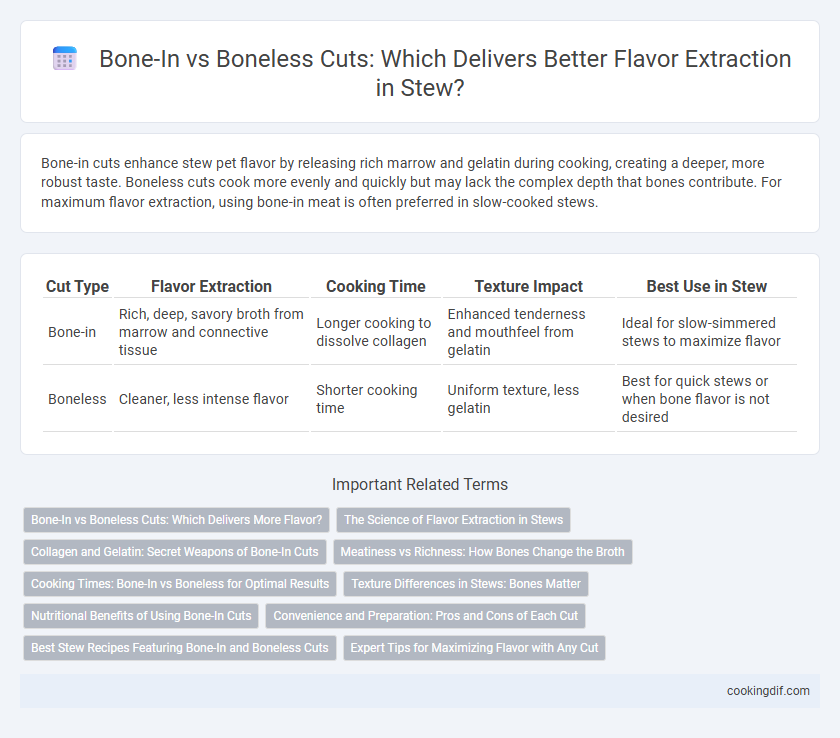Bone-in cuts enhance stew pet flavor by releasing rich marrow and gelatin during cooking, creating a deeper, more robust taste. Boneless cuts cook more evenly and quickly but may lack the complex depth that bones contribute. For maximum flavor extraction, using bone-in meat is often preferred in slow-cooked stews.
Table of Comparison
| Cut Type | Flavor Extraction | Cooking Time | Texture Impact | Best Use in Stew |
|---|---|---|---|---|
| Bone-in | Rich, deep, savory broth from marrow and connective tissue | Longer cooking to dissolve collagen | Enhanced tenderness and mouthfeel from gelatin | Ideal for slow-simmered stews to maximize flavor |
| Boneless | Cleaner, less intense flavor | Shorter cooking time | Uniform texture, less gelatin | Best for quick stews or when bone flavor is not desired |
Bone-In vs Boneless Cuts: Which Delivers More Flavor?
Bone-in cuts deliver more flavor for stews due to the marrow and connective tissues that release rich, savory elements during slow cooking. Boneless cuts, while easier to handle and quicker to cook, lack the depth of taste imparted by simmering bones. The collagen in bone-in meat breaks down into gelatin, enhancing the stew's texture and adding a robust, silky mouthfeel.
The Science of Flavor Extraction in Stews
Bone-in cuts in stews enhance flavor extraction by releasing collagen and marrow during slow cooking, which break down into gelatin and enrich the broth's texture and mouthfeel. Boneless cuts lack these natural flavor compounds, resulting in a less robust and complex stock. The Maillard reaction on browned bones and connective tissue further intensifies the depth and savory umami profile of the stew.
Collagen and Gelatin: Secret Weapons of Bone-In Cuts
Bone-in cuts excel in stew recipes due to their high collagen content, which breaks down into gelatin during slow cooking, enriching the broth with a rich, velvety texture and deep umami flavor. Collagen from bones and connective tissues transforms into gelatin, enhancing mouthfeel and creating a naturally thickened stew without added thickeners. Boneless cuts lack this collagen-rich advantage, often resulting in less flavorful and thinner liquids.
Meatiness vs Richness: How Bones Change the Broth
Bone-in cuts provide superior richness and depth to stew broth due to collagen and marrow that dissolve during long cooking, enhancing umami and mouthfeel. Boneless cuts yield a meatier profile with straightforward protein flavors but lack the gelatinous texture and mineral complexity imparted by bones. Using a combination of bone-in and boneless cuts balances robust meatiness with a silky, flavorful broth that elevates the overall stew experience.
Cooking Times: Bone-In vs Boneless for Optimal Results
Bone-in cuts require longer cooking times compared to boneless cuts due to the density and structure of the bone, which slows heat penetration but enhances flavor extraction in stews. The marrow inside bones releases rich gelatin and minerals during slow simmering, imparting depth and umami to the broth without overcooking the meat. For optimal results, cook bone-in cuts low and slow, typically 2-3 hours, while boneless cuts usually reach tenderness in 1-2 hours, allowing for quicker meal preparation with less flavor complexity.
Texture Differences in Stews: Bones Matter
Bone-in cuts release collagen and marrow during slow cooking, enriching stew with a silky, unctuous texture and deep, savory flavors. Boneless cuts tend to result in a leaner stew with a firmer bite, lacking the gelatinous mouthfeel contributed by bones. The presence of bones affects the stew's thickness and mouth-coating quality, making bone-in cuts preferable for a richer, more textured final dish.
Nutritional Benefits of Using Bone-In Cuts
Bone-in cuts in stew provide superior flavor extraction due to the marrow and collagen released during slow cooking, enhancing taste and texture. Nutritionally, these cuts supply essential minerals like calcium, phosphorus, and magnesium, which leach into the broth, boosting its health benefits. The gelatin from bone collagen also supports joint health and improves digestion, making bone-in stews more nutrient-dense than those made with boneless cuts.
Convenience and Preparation: Pros and Cons of Each Cut
Bone-in cuts enhance stew flavor by releasing marrow and collagen during cooking, creating a richer, more gelatinous broth, but they require extra preparation time and skill to carve around the bone. Boneless cuts offer greater convenience, making them easier and faster to handle, serve, and eat, ideal for quick stews or when ease of eating is a priority. Choosing between bone-in and boneless primarily depends on balancing the desired depth of flavor against preparation time and convenience in meal execution.
Best Stew Recipes Featuring Bone-In and Boneless Cuts
Bone-in cuts, rich in collagen and marrow, enhance stew flavor and texture, creating a deeply savory broth with natural gelatin. Boneless cuts offer convenience and quicker cooking times, absorbing spices and seasonings more uniformly for tender bites. Best stew recipes balance both, using bone-in beef shanks or short ribs alongside boneless chuck or sirloin for complex, rich flavor profiles and satisfying mouthfeel.
Expert Tips for Maximizing Flavor with Any Cut
Bone-in cuts release collagen and marrow during slow cooking, enriching stew with deep, savory flavors and a silky texture. Boneless cuts absorb seasonings more directly, allowing precise control over taste intensity and quicker cooking times. Experts recommend searing both types to lock in juices, then simmering low and slow for optimal flavor extraction and mouthfeel.
Bone-in vs boneless cuts for flavor extraction Infographic

 cookingdif.com
cookingdif.com